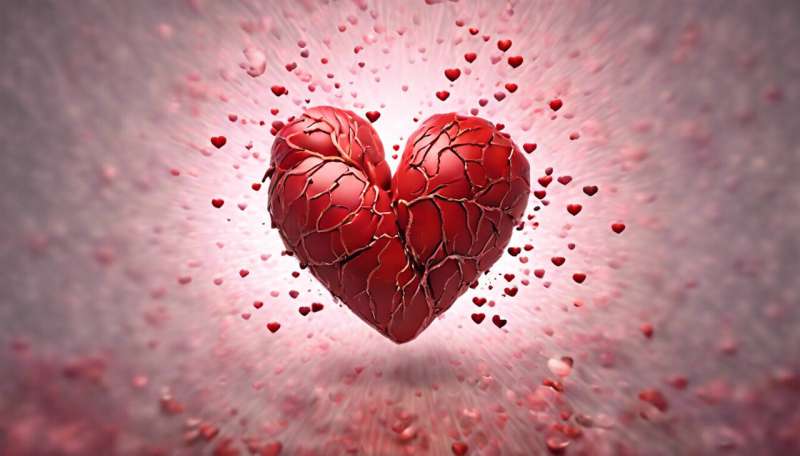This article has been reviewed according to Science X's editorial process and policies. Editors have highlighted the following attributes while ensuring the content's credibility:
fact-checked
trusted source
written by researcher(s)
proofread
A blow to the heart can kill you—or bring you back to life

I first became aware of the notion of the "touch of death" as a teenager—after watching Uma Thurman as the Bride finally kill Bill using the five-point-palm exploding-heart technique. More recently, news has broken that the death of political prisoner, Alexei Navalny, may have been a result of a single, forceful blow to the chest—apparently a trademark of the KGB.
Fact or fiction? These propositions are at best grossly speculative. But it is indeed possible for the heart to stop following trauma, through disruption at a particular point in its cycle of "lub-dub" beating. This phenomenon is named commotio cordis—literally "agitation of the heart".
The body region of interest here is the precordium, the area of the chest wall lying directly above the heart. This region is found in most of us on our left-hand side, with the heart's apex pointing towards the left nipple. Within this area, you can feel for the heartbeat. This is best when it is beating forcefully after exercise or exertion, as many of us will have experienced.
The precordium is a shield, made of the ribs and their muscles, which inflate and deflate our chest. Further swaddling is provided by the pericardium, a sac of membranes interposed with cuffs of shock-absorbing fat and fluid.
You can see that the heart is well protected, yet may still be vulnerable. In reality, commotio cordis is more frequently seen in young athletes, as a result of blunt impact trauma by a hard object such as a baseball or hockey puck. Most recently, the NFL player Damar Hamlin sustained commotio cordis as a result of a heavy tackle but was luckily resuscitated.
The good news for these athletes is that the window of opportunity for impact to trigger commotio cordis is small. First, the impact has to occur specifically to the precordium. Second, it must be of sufficient energy to deliver enough mechanical force to the heart's pumping muscle.
Third, it must occur in a very specific section of the heart's electrical rhythm. On a trace of the cardiac cycle—an electrocardiogram, or ECG—this is the region known as the T wave upstroke. This accounts for only about 1% of the whole cardiac cycle, making the likelihood (according to timing) around a one-in-a-hundred chance.
This makes commotio cordis a rarity, but nonetheless significant. The disruption of the cardiac cycle here can lead to a severe, potentially lethal rhythmic disorder. This is known as ventricular fibrillation. Medical teams must act quickly, using chest compressions, adrenaline and resuscitation with a defibrillator to restore a normal cardiac rhythm.
How to save a life
As much as a blow can be implicated in stopping a heart dead in its tracks, there are situations where it may be capable of doing the opposite.
Historically, part of the algorithm for treating a patient in cardiac arrest was to first strike the precordium once using the base of a clenched fist. This is called a precordial thump, and has worked its way into resuscitation scenes in medical series like Grey's Anatomy, though mostly for dramatic effect. In some cases, it has been found to restore normal heart rhythm, and therefore function.
The speculative reason as to why a precordial thump might work is the conversion of the mechanical force into tiny electrical currents that reset the heart's rhythm back to normal. However, it is this same mechanism that is also likely to be responsible for commotio cordis. This runs the risk of making the problem much worse.
The precordial thump has therefore fallen out of grace. Some studies have found no benefit for its use at all. As such, it has been removed from advanced life support guidelines in the UK.
So, despite being shielded by many layers of bone, muscle and membrane, the heart is still a delicate entity. You could be trained to strike the precordium at the correct site and with enough force. But being able to hit the heart at the precise time needed to trigger commotio cordis makes the reality of the death touch unlikely.
Perhaps being one of the 0.00008% of the population who have dextrocardia—a condition where the heart is secretly located on the right side of the body—might be in your favor.
This article is republished from The Conversation under a Creative Commons license. Read the original article.![]()




















